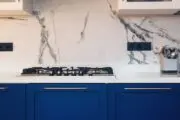Photo: Lauren Mitchell/Flickr
If you fire a single shot from the entryway aiming towards the rear, the bullet will make it through the back door without ever hitting a wall.
At least that’s how, legend goes, the shotgun house got its name. Its true origins as a housing type in New Orleans may have less romantic beginnings: a 19th-century real estate tax based on frontage rather than square footage, historians say, motivated long and narrow property sizes, likely making the elongated shotgun-style an architectural response to small urban lots.
A traditional New Orleans shotgun house is naturally space efficient — usually three to six times longer than wide, with a series of rooms lined up that each open to a single corridor running down one side of the house, from the front door to the back.
And in a time when climate change is increasing the frequency and intensity of extreme weather events that impact people living in urban areas, architects and designers are reviving the shotgun design for its potential as a resilient and sustainable building solution.
Perhaps the shotgun’s most defining feature is its lack of hallways. Occupants walk through private rooms to move around the house, a characteristic that has other theories suggesting the design developed not so much from property constraints as a social culture of early Louisianian settlers who were more gregarious and unwilling to sacrifice valuable living space for walking space.
Whichever the origin, the space-conserving design came to dominate the turn-of-the-century housing stock in the working-class neighborhoods of New Orleans, according to Richard Campanella, a geographer with the Tulane School of Architecture who has written extensively New Orleans. Campanella says the cost-effectiveness of the shotgun’s simple construction and efficient use of building materials also made the house attractive to the poorer classes of society.
Photo: Bart Everson/Flickr
But the increasing affluence of the 20th century, writes Campanella, brought an era of novel technologies — like mechanized kitchens, indoor plumbing, air conditioning, automobiles and municipal drainage — that spawned new philosophies about residential space where New Orleanians increasingly desired more privacy. Some builders added more hallways and side entrances to the typical shotgun, while others did away with the style altogether in favour of more modern bungalows.
Yet in the past decade, the shotgun house has been making a comeback in and outside of New Orleans: as cities increasingly have to grapple with rebuilding in the aftermath of destructive hurricanes, superstorms and floods (not to mention mitigate the release of greenhouse gas emissions responsible for climate change), urban designers are re-discovering the simple, low-energy form of the shotgun.
“Efficiency of form is a very, very important aspect when it comes to a passive (low energy consumption) house,” said Nicholas Discenza of the Toronto-based architecture firm, Sustainable.TO. “Designing a very efficient box will prevent heat loss and result in a more effective building, [and] the shotgun does a very good job of doing that.”
Paul Dowsett, the principal architect at Sustainable.TO, explains that after Hurricane Katrina devastated New Orleans in 2005, the houses that were still habitable during the extended power outage, once the water subsided, were the homes designed and built pre-electricity — the shotgun houses.
“The houses that were designed and built post-electricity and depended upon technology to function, they were actually not functional without electricity,” Dowsett said.
So when Dowsett and his team were invited to participate in an international competition to design a sustainable and affordable house on a lot in the Lower Ninth Ward in New Orleans, they starting thinking shotgun.
Their design mimics the traditional shotgun house in that both the front and rear doors line up along the south side of the house. Windows on both ends passively allow natural breezes to cross-ventilate the home instead of using active energy in mechanical air conditioning.
“These houses, transplanted to New York, learned a lot of things from previous, almost 200- years-ago development in New Orleans”
Dowsett’s revived shotgun has other features that reduce energy demand, such as large south-facing windows for passive daylighting and solar heating in the winter time. They also built an efficient building envelope with extra insulation to keep warm temperatures in during winter and hot temperatures out during summer, as well as a reflective roof that doesn’t absorb heat, reducing the demand for cooling.
Perhaps most importantly, the building is raised on stilts above the floodline, which means it’s flood resistant.
“[Original shotgun houses] were not as forward thinking as we are right now — they were built just a couple steps off of ground level,” said Donald Peckover, another designer with Sustainable.TO.
Indeed, the recipe for the shotgun house is not fixed and has been followed by others — some of the homes in Make It Right’s project in New Orleans were inspired by the shotgun, as well as a number of the pre-fabricated “Katrina Cottages” in rebuilt public housing complexes, according to Campanella’s research.
Nor is the modern use of the old design exclusive to Louisiana. Just this summer, construction began on a multi-family, shotgun-inspired house designed by Dowsett’s team in New York’s Far Rockaway neighbourhood, which was devastated by Superstorm Sandy in 2012.
“These houses, transplanted to New York, learned a lot of things from previous, almost 200- years-ago development in New Orleans,” Dowsett said.
And in Canada? Cities such as Richmond, BC and Calgary — vulnerable to sea level rise and prone to flooding — could also benefit from shotgun-inspired retrofits and new construction.
Climate experts say the historic flood that swept southern Alberta two summers ago and caused over $6 billion in damages, for instance, was not a one-off. Calgary, in particular, can expect more climate-change related urban flooding in its future.
“Climate change unquestionably is increasing the risk of intense rainfall [and] flooding that comes from sewers that are being overwhelmed by intense rainfall — that’s growing in frequency and severity,” said Paul Kovacs, the executive director of the Institute for Catastrophic Loss Reduction.
Tang Lee, an architect and professor at the University of Calgary, added that while re-drawing flood maps in Calgary is necessary for future flooding, it isn’t a permanent fix. “That might sound good if you were starting out with a new community, but there’s an existing community already on a flood [plain],” he said.
A more realistic strategy for those houses, said Lee, is raising them up on jacks or stilts — not unlike Sustainable.TO’s shotgun. “When the flood comes, you just move up,” he said.
Both Discenza and Peckover say their shotgun design could be easily transplanted to Calgary, although they don’t have any plans in the works.
Follow Kat Sieniuc on Twitter: @katsieniuc








